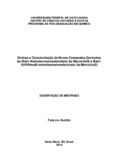| dc.creator | Bublitz, Fabrício | |
| dc.date.accessioned | 2015-03-06 | |
| dc.date.available | 2015-03-06 | |
| dc.date.issued | 2014-07-18 | |
| dc.identifier.citation | BUBLITZ, Fabrício. Synthesis and characterization of new compounds derived from Mercury(II) Bis(4-Aminobenzeneselenolate) and Mercury(II) Bis(4-N,N-Dimethyl-aminobenzeneselenolate). 2014. 94 f. Dissertação (Mestrado em Química) - Universidade Federal de Santa Maria, Santa Maria, 2014. | por |
| dc.identifier.uri | http://repositorio.ufsm.br/handle/1/10585 | |
| dc.description.abstract | This work presents the synthesis and structural analysis of the first compounds obtained through the use of the building blocks Mercury(II) bis(4-Aminobenzeneselenolate) Hg(SeC6H4NH2-4)2 and Mercury(II) bis(4-N,N-Dimethyl-Aminobenzeneselenolate) Hg(SeC6H4NMe2-4)2. Firstly, a synthetic procedure was adapted for the diaryl disselenides (4-H2NC6H4Se)2 (1a) e (4-Me2NC6H4Se)2 (1b), whose crystalline structures are been described here for the first time. From these disselenides, it were possible to obtain the mercury(II) selenolates Hg(SeC6H4NH2-4)2 (2a) e Hg(SeC6H4NMe2-4)2 (2b). By reacting 2a with mercury(II) halides and tricyclohexylphosphine, the complexes HgX(SeC6H4NH2-4)(PCy3) (3a, X = I and 3b, X = Br) and the pseudo dimer [HgCl(SeC6H4NH2-4)(PCy3)]2.2THF (4) were obtained. Instead, by reacting 2b with mercury(II) halides, the coordination polymer {[Hg2Br2(SeC6H4NMe2-4)2].DMF}n (5) and the polymeric cluster [Hg4Cl3(SeC6H4NMe2-4)5]n (6) were obtained. All the compounds with the exception of 2b were structurally determined by single crystal X-ray diffraction and 1(a-b), 2(a-b) were characterized by nuclear magnetic resonance. All the compounds were also analyzed by infrared vibrational spectroscopy and elemental analysis. | eng |
| dc.description.sponsorship | Conselho Nacional de Desenvolvimento Científico e Tecnológico | |
| dc.format | application/pdf | por |
| dc.language | por | por |
| dc.publisher | Universidade Federal de Santa Maria | por |
| dc.rights | Acesso Aberto | por |
| dc.subject | Selenolatos metálicos | por |
| dc.subject | Compostos de mercúrio(II) | por |
| dc.subject | Difração de raios X | por |
| dc.subject | Química de coordenação | por |
| dc.subject | Análise estrutural | por |
| dc.subject | Metallic selenolates | eng |
| dc.subject | Mercury(II) compounds | eng |
| dc.subject | X-ray diffraction | eng |
| dc.subject | Coordination chemistry | eng |
| dc.subject | Structural analysis | eng |
| dc.title | Síntese e Caracterização de Novos Compostos Derivados de Bis(4-Aminobenzenoselenolato) de Mercúrio(II) e Bis(4-N,N-Dimetil-aminobenzenoselenolato) de Mercúrio(II) | por |
| dc.title.alternative | Synthesis and characterization of new compounds derived from Mercury(II) Bis(4-Aminobenzeneselenolate) and Mercury(II) Bis(4-N,N-Dimethyl-aminobenzeneselenolate) | eng |
| dc.type | Dissertação | por |
| dc.description.resumo | Este trabalho apresenta a síntese e análise estrutural dos primeiros compostos obtidos utilizando-se os blocos de montagem bis(4-Aminobenzenoselenolato) de Mercúrio(II) Hg(SeC6H4NH2-4)2 e bis(4-N,N-Dimetil-Aminobenzenoselenolato) de Mercúrio(II) Hg(SeC6H4NMe2-4)2. Inicialmente adaptou-se um procedimento de síntese dos disselenetos de diarila (4-H2NC6H4Se)2 (1a) e (4-Me2NC6H4Se)2 (1b), cujas estruturas cristalinas estão sendo descritas aqui pela primeira vez. A partir destes disselenetos foi possível obter os selenolatos de mercúrio(II) Hg(SeC6H4NH2-4)2 (2a) e Hg(SeC6H4NMe2-4)2 (2b). Pela reação de 2a com haletos de mercúrio(II) e tricicloexilfosfina obteve-se os complexos HgX(SeC6H4NH2-4)(PCy3) (3a, X = I e 3b, X = Br) e o pseudodímero [HgCl(SeC6H4NH2-4)(PCy3)]2.2THF (4). Já pela reação de 2b com haletos de mercúrio(II) foram obtidos o polímero de coordenação {[Hg2Br2(SeC6H4NMe2-4)2].DMF}n (5) e o cluster polimérico [Hg4Cl3(SeC6H4NMe2-4)5]n (6). Todos os compostos com exceção de 2b tiveram sua estrutura determinada por difração de raios X em monocristal e os compostos 1(a-b) e 2(a-b) foram caracterizados por ressonância magnética nuclear. Todos os compostos também foram analisados por espectroscopia vibracional na região do infravermelho e análise elementar. | por |
| dc.contributor.advisor1 | Lang, Ernesto Schulz | |
| dc.contributor.advisor1Lattes | http://buscatextual.cnpq.br/buscatextual/visualizacv.do?id=K4786424E6 | por |
| dc.contributor.referee1 | Bresolin, Leandro | |
| dc.contributor.referee1Lattes | http://buscatextual.cnpq.br/buscatextual/visualizacv.do?id=K4792250U4 | por |
| dc.contributor.referee2 | Back, Davi Fernando | |
| dc.contributor.referee2Lattes | http://buscatextual.cnpq.br/buscatextual/visualizacv.do?id=K4701590T6 | por |
| dc.creator.Lattes | http://lattes.cnpq.br/1148982756535677 | por |
| dc.publisher.country | BR | por |
| dc.publisher.department | Química | por |
| dc.publisher.initials | UFSM | por |
| dc.publisher.program | Programa de Pós-Graduação em Química | por |
| dc.subject.cnpq | CNPQ::CIENCIAS EXATAS E DA TERRA::QUIMICA | por |


